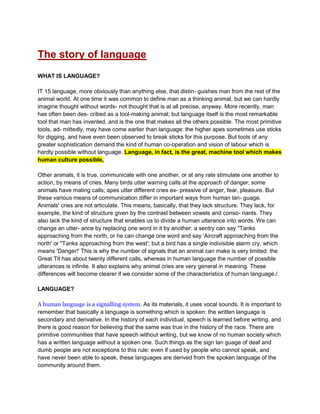
The story of language BS English literature notes
- 1. The story of language WHAT IS LANGUAGE? IT 15 language, more obviously than anything else, that distin- guishes man from the rest of the animal world. At one time it was common to define man as a thinking animal, but we can hardly imagine thought without words- not thought that is at all precise, anyway. More recently, man has often been des- cribed as a tool-making animal; but language itself is the most remarkable tool that man has invented, and is the one that makes all the others possible. The most primitive tools, ad- mittedly, may have come earlier than language: the higher apes sometimes use sticks for digging, and have even been observed to break sticks for this purpose. But tools of any greater sophistication demand the kind of human co-operation and vision of labour which is hardly possible without language. Language, in fact, is the great, machine tool which makes human culture possible, Other animals, it is true, communicate with one another, or at any rate stimulate one another to action, by means of cries. Many birds utter warning calls at the approach of danger; some animals have mating calls; apes utter different cries ex- pressive of anger, fear, pleasure. But these various means of communication differ in important ways from human lan- guage. Animals' cries are not articulate. This means, basically, that they lack structure. They lack, for example, the kind of structure given by the contrast between vowels and conso- nants. They also lack the kind of structure that enables us to divide a human utterance into words. We can change an utter- ance by replacing one word in it by another: a sentry can say "Tanks approaching from the north, or he can change one word and say 'Aircraft approaching from the north' or "Tanks approaching from the west'; but a bird has a single indivisible alarm cry, which means 'Danger!' This is why the number of signals that an animal can make is very limited: the Great Tit has about twenty different calls, whereas in human language the number of possible utterances is infinite. It also explains why animal cries are very general in meaning. These differences will become clearer if we consider some of the characteristics of human language./ LANGUAGE? A human language is a signalling system. As its materials, it uses vocal sounds. It is important to remember that basically a language is something which is spoken: the written language is secondary and derivative. In the history of each individual, speech is learned before writing, and there is good reason for believing that the same was true in the history of the race. There are primitive communities that have speech without writing, but we know of no human society which has a written language without a spoken one. Such things as the sign lan guage of deaf and dumb people are not exceptions to this rule: even if used by people who cannot speak, and have never been able to speak, these languages are derived from the spoken language of the community around them.
- 2. VOCAL SOUNDS The vocal sounds which provide the materials for a lan- guage are produced by the various speech organs (see Figure 1). The production of sounds requires energy, and this is usually supplied by the diaphragm and the chest muscles, which enable us to send a flow of breath up from the lungs. Some languages use additional sources of energy: it is possible to make clicking noises by muscular movements of the tongue, and popping noises by movements of the cheeks and lips, and such sounds are found for example in some of the languages of Africa. But in English we rely on the outflow of air from the lungs, which is modified in various ways by the 'set' of the organs that it passes through before finally emerging at the mouth or nose.